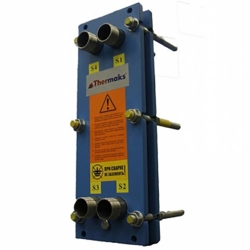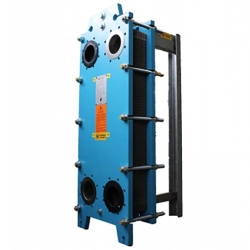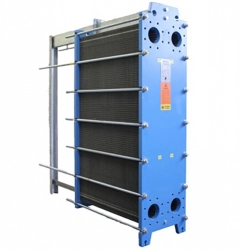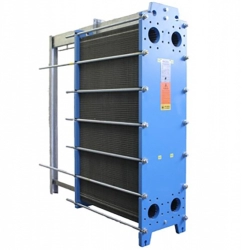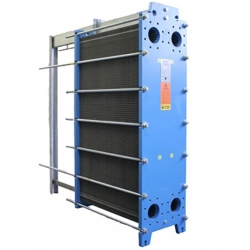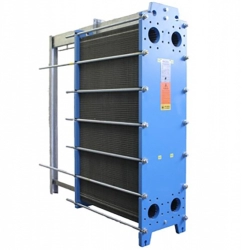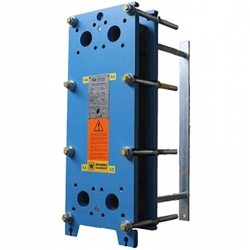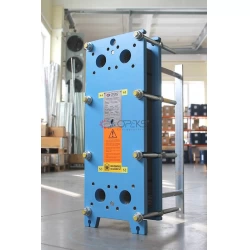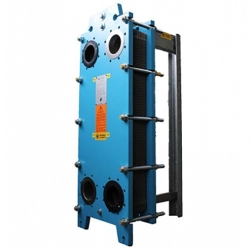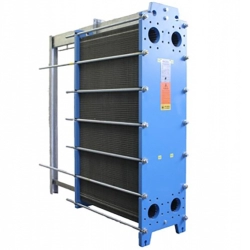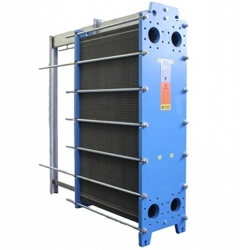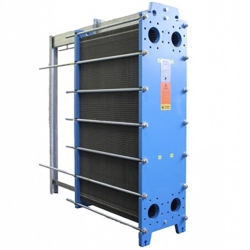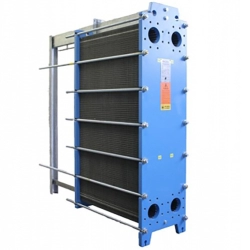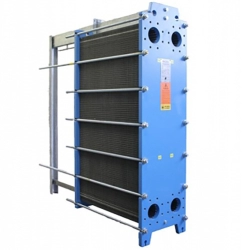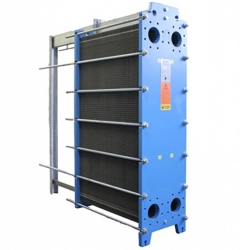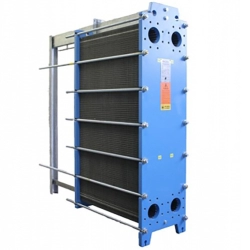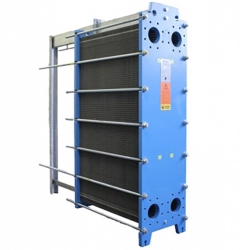Plate heat exchangers
 Plate heat exchanger THERMAKS PTA (GX)-7
Plate heat exchanger THERMAKS PTA (GX)-7
- Manufacturer: OPEKS (TRANTER)
- Thermal power: 10-400kw
 Plate heat exchanger THERMAKS PTA (GС)-8
Plate heat exchanger THERMAKS PTA (GС)-8
- Manufacturer: OPEKS (TRANTER)
- Thermal power: 10-400kw
 Plate heat exchanger THERMAKS PTA (GL)-8
Plate heat exchanger THERMAKS PTA (GL)-8
- Manufacturer: OPEKS (TRANTER)
- Thermal power: 10-400kw
 Plate heat exchanger THERMAKS PTA (GL)-8 food grade
Plate heat exchanger THERMAKS PTA (GL)-8 food grade
- Manufacturer: OPEKS (TRANTER)
- Thermal power: 10-400kw
 Plate heat exchanger THERMAKS РТА (GC)-28
Plate heat exchanger THERMAKS РТА (GC)-28
- Manufacturer: OPEKS (TRANTER)
- Thermal power: 10-400kw
 Plate heat exchanger THERMAKS РТА (GL)-9
Plate heat exchanger THERMAKS РТА (GL)-9
- Manufacturer: OPEKS (TRANTER)
- Thermal power: 50-900kw
 Plate heat exchanger THERMAKS РТА (GC) -30
Plate heat exchanger THERMAKS РТА (GC) -30
- Manufacturer: OPEKS (TRANTER)
- Thermal power: 50-900kw
 Plate heat exchanger THERMAKS РТА (GX)-12
Plate heat exchanger THERMAKS РТА (GX)-12
- Manufacturer: OPEKS (TRANTER)
- Thermal power: 50-2000kw
Shown 8 from 46
show all
 Individual heating station of the heating system according to an independent connection scheme
Individual heating station of the heating system according to an independent connection scheme
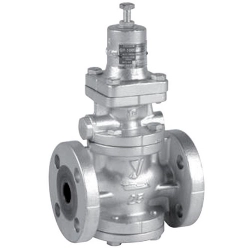 Reducing valve for steam Yoshitake GP-1000EN
Reducing valve for steam Yoshitake GP-1000EN
 Centrifugal steam separator OPEKS-1-SC16-1-F50
Centrifugal steam separator OPEKS-1-SC16-1-F50
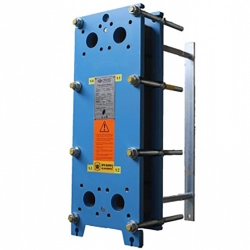 Plate heat exchanger THERMAKS РТА (GC)-16
Plate heat exchanger THERMAKS РТА (GC)-16
 Brazed heat exchanger SWEP B25T
Brazed heat exchanger SWEP B25T
 Brazed heat exchanger SWEP B25THx20
Brazed heat exchanger SWEP B25THx20
 Shell and tube coolers
Shell and tube coolers
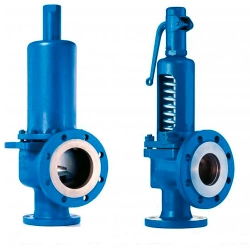 Safety valve LESER 441/442
Safety valve LESER 441/442
What is a plate heat exchanger
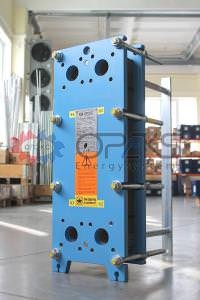
The device and principle of operation of plate heat exchangers
The design of the gasketed plate heat exchanger is based on profiled 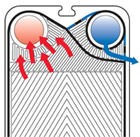
In addition to heat transfer plates and gaskets, the typical design of a gasketed plate heat exchanger usually includes:
- a fixed plate with inlet and outlet nozzles, which serves as a supporting "skeleton" for a set of plate packs;
- upper and lower guide consoles, on which "left", "right" plates and sealing gaskets are alternately "strung";
- a movable plate that closes the entire type-setting structure;
- threaded rods, with which the collapsible structure is fastened together and pulled together, until complete tightness in polymer seals is obtained;
- in two- and three-pass plate heat exchangers, where the coolants perform one or one and a half circles of circulation, special plates are used at the ends of the package, changing the direction of the flow.
Benefits and Limitations of Plate Heat Exchangers
The attractiveness of plate heat exchangers is that, in comparison with shell-and-tube heat exchangers, they are characterized by higher heat transfer coefficients, and with the same heat exchange area, they are able to transfer greater heat power. Thus, with the same thermal power, plate heat exchangers are characterized by much smaller dimensions and weight (metal consumption) than shell-and-tube heat exchangers. The efficiency of plate heat exchangers, among all their existing varieties, is currently considered the highest.
Other important advantages of gasketed plate heat exchangers are:
- the ability to modernize, in order to change the heat exchange area (heat output), which is done by simply adding or reducing the number of heat exchange plates in the package;
- easy accessibility and ease of maintenance (cleaning), realized by disassembly, which is unattainable for non-separable structures (welded or brazed).
Due to the use of polymer gaskets in the design of gasketed plate heat exchangers, they have certain restrictions on the conditions of use. As a rule, such restrictions are within:
- according to the temperature of the heat carriers used - up to 180 ° C;
- working pressure - up to 2.5 MPa (25 bar).
Plate heat exchangers manufactured by TRANTER
The Swedish company TRANTER is one of the leaders and 
- The GC and GL series symmetrical V-plate heat exchangers are used for a wide range of typical operating conditions. V-shaped plates with sharp corners reduce the flow rate, and with obtuse corners - reduce the pressure drop at the inlet and outlet of the heat exchanger.
- devices with GX plates (Ultraflex) , which have an asymmetrical herringbone profile. Such an asymmetric profile pattern allows, by combining the mutual orientation of the plates, to obtain six different configuration options for heat exchange circuits, and thus flexibly select the characteristics of heat exchange equipment for specific conditions and tasks.
- reinforced double plates GD - are used to ensure extremely high reliability and safety of the heat exchange equipment, to guarantee the immiscibility of the working media in all operating modes. The need to guarantee such conditions often arises in pharmaceuticals, food production, cooling systems for electrical equipment, etc.
- heat exchangers on GF plates with profiles (through channels) of increased cross-section (depth and width). Such devices are used to work with high viscosity heat transfer fluids, or contaminated solid (fibrous) particles.
- GW plates are semi- welded (welded in pairs) - as a rule, they are used in heat exchangers where hazardous substances such as ammonia or freons are used, and where it is necessary to achieve increased tightness of the circuits.
Advantages of THERMAKS plate heat exchangers
OPEKS 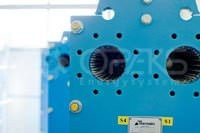
- a wide range of models, including more than 30 items, which allows you to select heat exchangers for a wide variety of operating conditions, with a thermal power from 1 kW to 30 MW;
- using only high-quality heat exchange plates - symmetrical, asymmetric, with a wide channel, reinforced double and welded in pairs - of the original TRANTER production quality (GX, GC, GL, GD, GW, GF series), and the same reliable sealing gaskets, in thickness and quality which it is not customary for OPEKS to save;
- exclusion of the possibility of contact of aggressive heat carriers with corrosion-unstable materials anywhere in the structure of the heat exchanger;
- the use of structural solutions (such as a special roller bracket) that facilitate the disassembly, assembly and maintenance of heat exchangers, even when working with very heavy structural elements - plates and plates.
- Aesthetic appearance that underlines the high quality workmanship.
- Plate material stainless steel steel AISI316 (1.4401), 304 (1.4301), Titanium, Hasteloy, SMO254
- THERMAKS heat exchangers provide efficient performance of any technological task thanks to a wide range of plate reliefs, including plates with small corrugations for clean environments and wide-channel reliefs for polluted environments.
- Seal material for various media and temperature conditions - synthetic rubber EPDM-P, NBR-P, Viton, Fluor, others
- Seals of 2 types: for glue or clip fixation
- The seals are distinguished by their powerful appearance and have the largest cross-section among heat exchanger manufacturers, which ensures a long service life before replacement (up to 10 years), and the seals are not damaged during repeated disassembly of heat exchangers
- Due to the strength class of galvanized tie bolts 8.8, the thread does not deform during operation
- The upper rail on which the plate pack is suspended,

- The upper and lower supporting beams are galvanized.
- Connecting pipes can be made of stainless steel, titanium, other alloys, excluding contact of the coolant with the plate material
- A roller bracket is installed in the mounting structure of the movable plate to facilitate the rollback of the heavy movable plate along the upper supporting beam
- The frame can be made in 3 pressure standards PN10, PN16, PN25 bar.
- The maximum operating temperature is up to 180 C.
- High-quality packaging for transportation, storage and movement to the installation site of each individual unit.
- Guarantee not less than 2 years
The principle of operation of the plate heat exchanger THERMAKS
When ordering heat exchangers OPEKS ENERGOSYSTEMY you get more than you expected!
Questions-Answers
What is a plate heat exchanger?
A plate heat exchanger is a device that transfers heat between two media through a set of metal plates. OPEKS is a manufacturer of plate heat exchangers and supplies equipment for heating, DHW systems, and industrial applications.
What types of plate heat exchangers does OPEKS manufacture?
We manufacture gasketed, brazed, and welded plate heat exchangers. The type of unit is selected based on application and operating parameters.
How to choose the right heat exchanger?
Selection depends on temperature, flow rate, and pressure. OPEKS engineers provide free calculations and help choose the optimal model for your project.
Where are plate heat exchangers used?
OPEKS plate heat exchangers are used in heating systems, domestic hot water, ventilation, district heating stations, and various industrial processes.
What materials are used in OPEKS heat exchangers?
We use stainless steel and copper, and for aggressive media — titanium and special alloys. This ensures durability and reliability of the equipment.
Is there a warranty on OPEKS heat exchangers?
Yes. We provide official warranty and service support for all types of plate heat exchangers.
Do you deliver across Ukraine?
Yes. We deliver equipment throughout Ukraine via transport companies or our own logistics.
Can I pick up the product myself?
Yes. Self-pickup is available from our warehouse in Kyiv upon prior arrangement.
How fast can I get a heat exchanger?
Most models are in stock. We also manufacture heat exchangers to order in short lead times.
Do you provide technical calculations?
Yes. We provide free technical calculations for heat exchanger selection based on your operating conditions.

